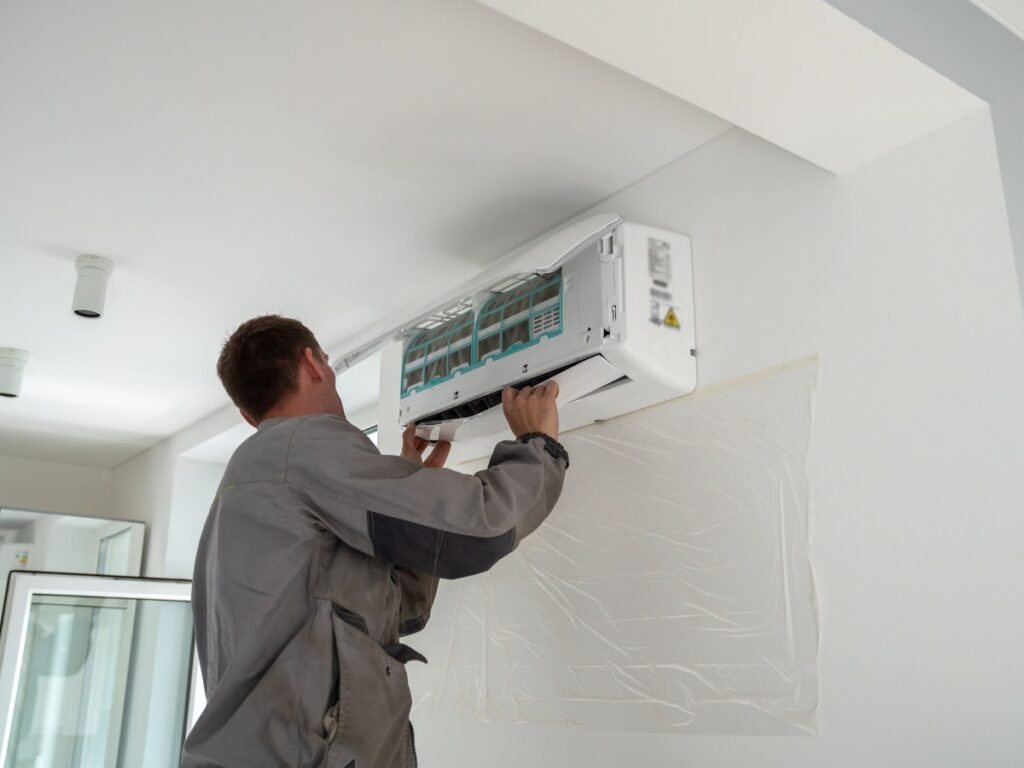Welcome to TOP AC Inc your go-to mini split AC installation source. Whether you’re a homeowner looking to cool or heat specific areas of your home or a contractor seeking guidance on the installation process, we’ve got you covered.
This blog will provide a comprehensive guide to mastering mini split AC installation. From understanding the functioning of these ductless air conditioning systems to choosing the right system for your needs, we will cover everything, from pre-installation considerations to post-installation care. So, let’s dive in and become experts in mini split AC installation!
The Functioning of a Mini Split AC
The functioning of a mini split AC involves the efficient management of airflow and temperature through the use of refrigerant lines. These lines connect the indoor unit, which contains the evaporator coil, to the outdoor unit, which houses the condenser coil. The refrigerant, typically R-410A, flows through these lines, absorbing heat from the indoor air and releasing it outside. This heat exchange process allows the system to cool the indoor air.
In addition to cooling, mini-split AC systems can also provide heating. By reversing the refrigerant flow, the system acts as a heat pump, extracting heat from the outdoor air and transferring it indoors. This versatile functionality makes mini split ACs suitable for year-round use, providing cooling and heating as needed.
Understanding the functioning of a mini split AC is essential for efficient operation, allowing homeowners and contractors to make the most of these innovative HVAC systems.
Choosing the Right Mini Split System for Your Needs
When selecting a mini-split system, a few key factors must be considered. First, assess the space size you intend to cool or heat. Mini split systems are available in various cooling capacities, measured in British Thermal Units (BTU), and choosing the right size ensures optimal performance.
By assessing room size, insulation, climate, and energy efficiency ratings, you can determine the ideal mini-split system for your cooling and heating needs. Consulting with an HVAC professional can provide valuable insights and help you choose your home or project best.
Pre-Installation Considerations for Mini Split AC
Before diving into the installation process, remember a few critical pre-installation considerations. Carefully evaluate the electrical wiring in the installation area and ensure that it can accommodate the power needs of the mini-split system.
Mini split AC systems require interior and exterior wall space for mounting the units. Adequate clearance is essential for proper airflow and system operation.
Space Requirements for Mini Split AC
Proper space requirements are crucial for efficiently installing and operating a mini split AC system. Begin by identifying suitable locations on both exterior and interior walls for mounting the units.
On the exterior wall, ensure enough space to accommodate the outdoor unit, the condenser unit. The unit should be placed on a stable surface, such as a concrete pad, and positioned away from direct sunlight. Good airflow around the outdoor unit is essential for optimal performance, so provide adequate clearance from obstructions.

Power Needs for a Mini Split AC
Understanding the power needs of a mini split AC system is essential for a safe and effective installation. Evaluate the electrical connections required for both the indoor and outdoor units. Ensure that the electrical circuit can support the power demands of the mini-split system. Consider installing a disconnect box near the condenser unit for the outdoor unit.
This allows for easy electrical access in case of maintenance or emergencies. When connecting the units, follow the manufacturer’s instructions for electrical wiring to ensure proper installation and operation. It is crucial to consult with a qualified electrician if you need clarification on the electrical requirements or connections of the mini-split system.
Step-by-Step Mini Split AC Installation Guide
Now that you have considered the pre-installation requirements let’s dive into the step-by-step installation process of a mini split AC system. Although hiring a professional for the installation is recommended, having a basic understanding of the process can be helpful.
The installation process involves:
- Mounting the indoor unit.
- Setting up the outdoor unit.
- Connecting the indoor and outdoor units.
It also includes installing refrigerant lines, electrical wires, and other necessary components. To ensure a successful mini-split AC installation, let’s explore these steps in detail.
Mounting the Indoor Unit
Mounting the indoor unit is the first step of the installation process. Follow these steps to mount the indoor unit securely:
- Identify the location on the interior wall where the indoor unit will be mounted. Ensure that the wall can support the unit’s weight, typically ranging from 15 to 60 pounds, depending on the model.
- Use a stud finder to locate the studs in the wall. Mounting the unit to the studs provides stability and prevents vibrations during operation.
- Before mounting the unit, drill a pilot hole for the line set and electrical wires. This hole should be level and parallel to the floor, allowing for proper installation and refrigerant flow.
Setting Up the Outdoor Unit
After mounting the indoor unit, the next step is setting up the outdoor unit, the condenser unit. Follow these steps to ensure proper installation:
- Select an appropriate location for the outdoor unit. It should be positioned on a stable surface like a concrete pad to prevent movement and vibrations.
- Place the outdoor unit in an area where it receives good airflow and is not subject to direct sunlight. Direct sunlight can affect the efficiency and performance of the unit.
- Ensure adequate clearance around the outdoor unit, allowing for proper airflow and maintenance access. Consult the manufacturer’s guidelines for the recommended clearance requirements.
Connecting the Indoor and Outdoor Units
The connection between the indoor and outdoor units is crucial in the mini-split AC installation process. Follow these steps to establish the necessary connections:
- Run the line set, which consists of copper tubing, refrigerant lines, and electrical wires, from the indoor unit to the outdoor unit. The line set carries the refrigerant, allowing for the heat exchange process.
- Use appropriate connectors, such as flare fittings, to establish secure connections between the line set and the indoor and outdoor units.
- Ensure that the refrigerant lines are properly insulated, preventing energy loss during the cooling and heating.
Safety Measures During Installation
During the installation process, it is essential to prioritize safety to prevent accidents or damage to the system. Here are some essential safety measures to keep in mind:
- Wear appropriate personal protective equipment, such as gloves and safety goggles, to protect yourself during the installation.
- Follow all electrical safety precautions, including shutting off the power supply and using insulated tools when working with electrical connections.
Maintenance Tips for Prolonged Efficiency
To maximize efficiency:
- Ensure evaporators stay clean for consistent cooling.
- Promptly address any condenser unit refrigerant leaks.
- Check ductwork for airflow hindrances like leaks or obstructions.
Clear debris around the outdoor unit regularly to prevent airflow restrictions. Address condensate drainage issues promptly to prevent water damage.
Why Opt for Professional Installation?
Professional mini split AC system installation offers several advantages over DIY installation. Here’s why you should opt for professional installation:
- Expertise and knowledge: HVAC contractors have the expertise to size the system accurately, ensure proper wiring, and handle refrigerant safely. Our knowledge and experience minimize the risk of installation errors and ensure optimal system performance.
- Warranty requirements: Many mini-split systems require professional installation to maintain warranty coverage. Hiring a professional ensures you comply with the manufacturer’s warranty terms, protecting your investment.
- Efficiency and cost savings: Professional installation maximizes the system’s energy efficiency, resulting in long-term cost savings on energy bills. HVAC contractors understand the importance of proper installation techniques, which leads to better overall system efficiency.
Mastering mini split AC installation requires attention to detail and adherence to safety measures. Choosing the right system, understanding the installation process, and prioritizing post-installation care are crucial for optimal performance.
Professional installation offers benefits like expertise and efficiency, ensuring a smooth setup. Remember, regular maintenance and timely service can prolong the lifespan of your mini split AC. Following the steps outlined in this guide, you can enjoy efficient cooling and comfort in your space.

